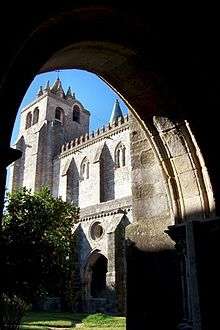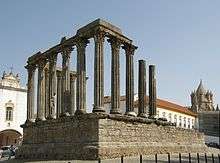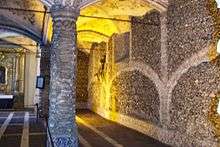Évora
Évora is a city and a municipality in the district of Évora, in the Alentejo region of southern Portugal. It is a historic city.

Get in
You can get to Évora in several ways:
- By bus , (from Lisbon the ticket is around 10 euros for students and around 12 euros without discount )
- By car (distance: 140 km, from Lisbon take the A2 by either bridge, then A6, then N114 to Évora; tolls)
- By train (distance: 130 km). There are 4 trains to Évora daily (5 trains on Sundays). The trip takes 1h20 and it's a very comfortable train. The Évora train station is located close to the city center (around 10 min walking). You can check the timetable of trains in the official website of Comboios de Portugal.
Get around
One of the nicer ways to see the city is by horse carriage ride. You can find them near the Cathedral.
Otherwise there's no real problem in walking between most of the main sights.

See
While there are some Roman ruins that you definitely need to check out, there is also the Capela dos Ossos (Bone Chapel), which is totally ornamented with human bones, surreal, perhaps creepy to some but a must see. Contrary to what is often said, it is not unique.

The old aqueduct with houses built into the arches is interesting. It is completely dissimilar from the superbly structured one at Elvas except that both seem far too much work for the trickle of water they carried.
You must visit the Almendres Cromlech megalithic complex, an important megalithic monument in the Iberian Peninsula. It is the largest extant group of structured menhirs in the Iberian Peninsula, and one of the largest in Europe. It's situated about 10 km from Évora, going by Guadalupe. Continuing along this trip, near Valverde, the Anta do Zambujeiro dolmen is also very unusual by its size.
In less than an hour, you can get by car to Monsaraz (exit via IP2 to Beja, then turn to Reguengos), a nice, well preserved walled town on top of a hill overlooking the Alqueva Dam waters. There's plenty where to sleep (cheap Bed and Breakfast and Turismo de Habitação, and an Inn) and where to eat. Around it are a couple important menhirs, one of them with engravings (Balhoa) and the other about 5 meters high, and a anta (passage dolmen). The Xares cromlech is a conjectural reconstruction, and was removed from its original place due to the Alqueva waters.
Do
- There is a nice and big park (Jardim Público) where you can have a nice stroll.
- Show yourself and see others at the Praça do Giraldo, the city's social center
- Roman ruins - Templo de Diana
- Évora Cathedral and Cloisters
- Historic Centre of Évora - UNESCO World Heritage Site.
- Évora University main building (on an ancient Convent, founded in 1559)
- Eat and drink local and regional products.

Buy
Shops are open a little later than other places in Europe, usually around 9:30AM-19.30PM, and the lunch breaks can be quite long, usually from 1PM to 3PM.
Shopping streets
- Rua 5 de Outubro: From Praça do Giraldo to Sé. It's a pedestrian street with several small shops where you can buy souvenirs and clothes. The most typical souvenirs are honey, olives, all kind of object made by cork, home made jams, slippers made by sheep wool, etc.
- Rua João de Deus: a number of independent shops and services and well as known brands such as Pull and Bear, Pepe Jeans, Kids' Class, etc.
There are no malls in Évora.
Markets
- Farmers' market, praça 1º de Maio (close to the public garden). 6AM-13PM Saturday. An out door market offering the freshest fruits and vegetables from the local farmers.
- Food market, praça 1º de Maio (inside the building in the middle of the square). Every day in the morning. You can find fresh fish, vegetables, fruits, cheeses, hams, flowers, bread, meat, and other local food.
Eat
There are several traditional dishes:
- Açorda
- Migas com carne de porco
- Carne de porco à alentejana
There are also several traditional desserts, all from conventual origin:
- Sericaia
- Bolo podre
- Pão de Rala
- Mel e Nóz
Drink
Drink and carry plenty of water especially in the hotter months (July and August, eventually September). Especially in August, you will be advised not to go out in the sun between 2PM and 4PM, unless you are used to it.
Remember that just going in for a drink is a perfectly acceptable way of getting in to see the public areas of a Pousada.
Alentejo wines are some of the best-loved in Portugal, and there's a variety of them. Some can be quite expensive.
Sleep
- The Herdade Água D'Alte Aldeia da Serra nº14, Redondo, Evora. Água d'Alte was completely rebuilt. Its location and quietness offers you excellent conditions for your resting and for nature tourism. Here you will find: two country houses (T1 + T2), plus 5 complete suites and 2 double rooms.Visit our website at http://www.aguadalte.com
- Pousada de Évora - Lóios, Historic Luxury Hotel, Largo Conde Vila-Flor 7000-804 Évora, ☎ +351 266 730 070, fax: +351 266 707 248, e-mail: recepcao.loios@pousadas.pt. This luxury hotel is located in the heart of historic the centre of Évora, a city classified by UNESCO as World Heritage. The Pousada de Évora, Convento dos Lóios, was originally a convent and one of Évora's most precious architectural buildings.
- Pousada de Vila Viçosa - D. João IV, Historic Luxury Hotel, Convento das Chagas - Terreiro do Paço 7160-251 Vila Viçosa, ☎ +351 268 980 742, e-mail: recepcao.djoao@pousadas.pt. The Pousada de Vila Viçosa, D. João IV, is set in the former Convent of Chagas de Cristo in the historical village of Vila Viçosa. Very characteristic with its intricate themed rooms, full of legends and tales.
- Pousada de Estremoz - Rainha Santa Isabel, Pousada Histórica, Largo de D. Diniz 7100-509 Estremoz, ☎ +351 268 332 075, fax: +351 268 332 079, e-mail: recepcao.staisabel@pousadas.pt. The castle of Estremoz is the result of the restoration of the magnificent Palace that King D. Diniz built for his wife, Queen Isabel, the Saint.
- Pousada de Arraiolos - Nossa Senhora da Assunção, Historic Luxury Hotel, Convento dos Lóios 7041-909 Arraiolos, ☎ +351 266 419 340, +351 266 419 365, fax: +351 266 419 280, e-mail: recepcao.assuncao@pousadas.pt. The Pousada de Arraiolos, Nossa Sra. Assunção, is an example of perfect harmony between the traditional and modern concepts of Portuguese architecture, adapting the austerity of a 16th-century convent to today's standards of comfort and well-being.
There are several hotels and you can get directions in the Tourist Office, which is located in the main city square - Praça do Geraldo.
- Casa Palma, rua Bernardo Matos29A. 20 euros for a double (in February 2006, required some haggling).
- Hotel Ibis Évora, Quinta da Tapada Urbanizaçao da Muralha, ☎ +351 266 760 700.
- Casa D. Antónia (Turismo Rural Alentejo), Rua Direita, 15 Monsaraz, ☎ +351 266 557 142, fax: +351 266 557 142, e-mail: info@casadantonia-monsaraz.com. A simple family environment is a principal characteristic of Casa D. Antónia. It has one suite and six rustic double rooms, all offering air conditioning, cable TV, private bathroom with WC, and a breakfast typical of the region.
It has an Alentejan patio with a garden offering panoramic views to the west. Here you can enjoy the pleasure of looking out over the remarkable landscape of this vast plain. The summers are hot and dry, the winters short, with rain and sun.
Our mission is to combine an enjoyable family atmosphere with the kind of comfort and tranquillity so many seek in this day and age.
There's a multitude of Bed And Breakfasts, though most will be fully booked during the high season.
Go next
- Lisbon
- Setúbal
- Alcácer do Sal
- Santarém
- Beja, Serpa, Mértola (then you can exit to Spain or the Algarve)
- Portalegre, Marvão, Castelo de Vide (then you can exit to Spain or Castelo Branco)
- Castelo Branco
- Fátima